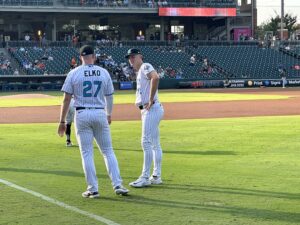White Sox’s paltry MLB draft bonus pool a result of unsound priorities
With all qualifying offer decisions put to rest after Scott Boras’ announcement that former New York Mets outfielder Michael Conforto will not be signing a contract with a major league club this year, the league has finalized draft slots and bonus pool amounts for the 2022 MLB Draft. The Chicago White Sox will have $6,289,100 available in their bonus pool as mentioned by Josh Nelson in the latest Sox Machine Draft Report.
That figure is the third lowest bonus pool total in the sport, just ahead of the Los Angeles Dodgers and San Francisco Giants. The league considers the Pale Hose to be a large-market revenue generator despite their history of middle-market spending and due to that association, they don’t receive any compensatory selections that would accelerate their potential bonus pool amount.
The front office should refrain from any narrative about not properly procuring enough talent via the draft due to their decreasing bonus pool space while contending at the big league level however. Since the brain trust at 35th and Shields is often run like a mafia family and outsiders struggle to discern the responsibility level of actions for particular club employees, nobody really knows who decided to willfully ignore the possibility of adding an additional top-100 draft selection this off-season.
The Carlos Rodòn conundrum was one of the most puzzling decisions of the winter. Not being willing to pony up a market value contract for the southpaw is a defensible position for an organization familiar with his health history and work habits. Eschewing the chance at receiving draft compensation that would come with his free agent departure because the franchise was unwilling to gamble on the possibility of another one-year pact is organizational malpractice.
Had the White Sox extended their free agent left-hander a qualifying offer, the organization would’ve received the 80th overall pick in the 2022 draft along with an additional $800,000 injected into their bonus pool. The only potential downside for the club would be paying a $4.9 fWAR starting pitcher $18.4 million to pitch for them this season; something that it appears they were wholly unwilling to do. Instead of possessing one of the smallest pools in the league for the upcoming draft, the club would’ve been around 22nd overall.
There is a real chance that Rodòn would have accepted the qualifying offer, but despite what the organization believes, that would’ve been a desirable outcome. The club may not have had the financial incentive to budget for additions like Josh Harrison, Joe Kelly and ultimately Johnny Cueto with the lefty in the fold but observers would’ve been too busy celebrating to care.
By not extending the offer, the White Sox ultimately get neither. Carlos Rodón is thriving in San Francisco and the defending American League Central champions don’t possess an extra draft pick with expanded bonus pool space to show for what was an incredibly shrewd signing followed by an eventual departure. The extra pick could be the difference between landing two top-50 draft prospects instead of three. It could have provided a boost that the worst farm system in baseball could use.
On the other hand, we’re talking about the 80th overall pick and there’s only so much value to be gleaned from it. The issue is ultimately that the organization decides to draw arbitrary lines in the sand and often ends up appearing penny-wise and pound-foolish once their decision-making process gets analyzed. There isn’t another large market contender in the league that would’ve acted in this manner if presented with the exact situation.
Salvaging the Situation
Teams with small bonus pools are still able to select and sign good players annually in the draft, it’s just harder to accomplish. The White Sox chose this path, and while it could have been easier, last year’s draft approach seems like an appropriate predictor of what’s to come.
The White Sox spent $6,942,000 against their bonus pool in the 2021 Draft. Under the leadership of Mike Shirley over the last two years, and his predecessor Nick Hostetler in prior seasons, the club has often exceeded their pool. $6,618,600 was the allotted pool space that the organization was entitled to and they swiftly used all of it plus the maximum overage penalty before draft picks are taken away.
Clubs are allowed to spend up to 5 percent over their pool while paying a 75 percent overage tax on the extra amount spent. The players chosen in the first 10 rounds count against a club’s bonus pool. Players taken from the 11th through 20th rounds don’t count against the pool unless the bonus exceeds $125,000, and only the overage will count against the pool. The White Sox have done a solid job of adding talented players to their farm system on Day 3.
White Sox 2022 Draft Picks
- 1st round #26: $2,788,00
- 2nd round #62: $1,158,600
- 3rd round #101: $606,300
- 4th round #131: $452,700
- 5th round #161: $337,400
- 6th round #191: $261,600
- 7th round #221: $205,600
- 8th round #251: $171,700
- 9th round #281: $157,700
- 10th round: #311: $149,500
Taking money from the later-round picks in order to pay players over-slot bonuses in the second through fourth rounds has become a trend for the White Sox in recent years. They’ve also begun to incorporate more prep players into the organization as well and both trends likely continue in 2022 in some fashion.
Indiana prep shortstop Colson Montgomery became the first high school player selected in the first round by the organization since tabbing Courtney Hawkins out of a Texas high school back in 2012. The White Sox often pay the slot value for their first-rounders and the multi-sport athlete did so when inking for $3,027,000. The White Sox have also employed a strategy that allows them to add upside at the top of the draft while cutting severely under-slot bonuses throughout day two (rounds 5-10).
The club went over-slot in the second, third and fifth rounds to sign Arizona prep infielder Wes Kath, Maryland right-hander Sean Burke and Nevada prep righty Tanner McDougal. The White Sox went on to add college players throughout, and a few of those players drafted the sixth through 20th rounds have crept onto team top-30 lists over the past year. A similar approach should be expected once the 2022 draft kicks off in July and the strategy is a familiar one for the current team of decision makers.
There’s still two months until the draft kicks off on July 17 from the Los Angeles, but the White Sox could choose to go a number of directions. In the first round specifically, teams claim to always take the perceived best player available, but bonus pools complicate that process in baseball. The goal of the draft is to accumulate as much talent within the bonus pool as possible.
The White Sox can do a solid job on draft weekend and any demographic is likely on the table in the first round. Pitching is always an organizational need and the club could use help at catcher as well. Doubling up on prep position players could be an option again with names like Roman Anthony out of Florida and Ryan Clifford from North Carolina as players to monitor early on.
On the prep pitching side, there will be a number of players available. The White Sox haven’t selected a high school pitcher in the first round since Kris Honel back in 2001 but they’ve added a plethora of prep arms in subsequent rounds in recent years. If he were to somehow be available, Indiana prep right hander Andrew Dutkanych would likely interest Indiana native and scouting director Mike Shirley.
Falling back on old reliable, the college pitching class is injury-ravaged, but deals could be had with players in the 25-50 range that might have been top-20 picks without the injuries. During the rebuild, the focus of the club’s first-rounders was on college position players, and the organization could go that route again with someone like Tennessee center fielder Drew Gilbert.
The White Sox will have 20 picks this July and Mike Shirley and his staff will attempt to continue the restocking of talent that will be necessary for this farm system to continue churning out talent. While the bonus pool is small, it’s enough to add quality players. It could have been easier though, and the White Sox just make things more difficult than they have to be much more often than they should.







Great article. I regret not reading more FutureSox prior to the merger.
Good work. But I still think not offering the QO to Rodón is defensible. If you don’t think he’ll last the full season/be a factor in the playoffs, then you shouldn’t offer the QO. The chance at a 2nd round pick isn’t worth it.
Now, how they spent that $18m is another story…
He threw multiple times more innings last year than he threw the previous 3 years combined. If you didn’t know he was going to run out of gas at the end of the year, I don’t know what to tell you.
Have to disagree. When is anyone you sign guaranteed to last a full season ? They had a chance to offer one of the best pitchers in baseball a 1 year contract. Look what the ancient and coming off 2 yrs of not pitching Verlander got. How about ancient Scherzer ? Syndergaard , another guy with basically 2 years off like Verlander and just like Rodon last year. Were they signed because they were shoe-ins to last all season and pitch in the playoffs ?
It’s the job of the front office to make the team better. No QO means other teams have a chance to sign him cheaper than with a draft pick attached. Apparently the FO was working for the rest of baseball. Rodon wasn’t going to take the QO. He and Boras knew his worth a lot better than some fans and the front office. The off season was an unmitigated disaster and it’s showing on the field.
There were 2 reasons to not offer the QO, his arm was already toast (proven wrong so far, even if he has not made it through a season yet), or you were able to sign him in 2021 under the agreement to not offer the QO.
Good analysis. I think what’s most frustrating for me is they had 2 major decisions on picking up options and Hahn didn’t treat them as mutually exclusive. Seemed like it was with Rodon or Kimbrel & he chose the latter because of what he gave up in trade. While getting Pollack for Kimbrel was good value (so far, so-so performance wise), not keeping both because of financial implications is just another example of the Sox being selectively cheap.
If the Sox had confidence that Kimbrel still had trade value, I just don’t understand why they wouldn’t have confidence in Rodon’s trade value. The SF deal proves how poorly Rick Hahn misread the market.
I believe a player who accepts a QO cannot be traded until June
*without their permission. Signings can waive that, I believe.
Sadly, I think you are right about the front office’s logic. Rodon was cheap to acquire and Kimbrel was expensive. Someone needs to explain the sunk cost fallacy to these guys.
I thought the only defense of not picking up Rodon’s option was if they were pinching pennies to land a big name or two and couldn’t risk any amount of their finances on him. Needless to say, without a single major signing in the offseason, it’s pretty damn stupid.
Rodon was a big name. Too many fans and the FO just refused to believe it.
I kinda thought maybe they were not extending the QO as a favor to Rodon, knowing that he was going to get the best multi-year offer from another team. However, Boras’s comments don’t suggest this and no one from the White Sox has said this, so it seems like it was just a straightforward risk/reward calculation that they messed up.